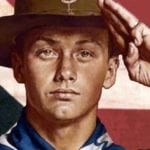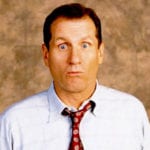 Movies and TV
Movies and TV  Movies and TV
Movies and TV  History
History 10 Things You Didn’t Know About the American National Anthem
 Technology
Technology Top 10 Everyday Tech Buzzwords That Hide a Darker Past
 Humans
Humans 10 Everyday Human Behaviors That Are Actually Survival Instincts
 Animals
Animals 10 Animals That Humiliated and Harmed Historical Leaders
 History
History 10 Most Influential Protests in Modern History
 Creepy
Creepy 10 More Representations of Death from Myth, Legend, and Folktale
 Technology
Technology 10 Scientific Breakthroughs of 2025 That’ll Change Everything
 Our World
Our World 10 Ways Icelandic Culture Makes Other Countries Look Boring
 Misconceptions
Misconceptions 10 Common Misconceptions About the Victorian Era
 Movies and TV
Movies and TV The 10 Coolest Stars to Set Sail on The Love Boat
 History
History 10 Things You Didn’t Know About the American National Anthem
 Technology
Technology Top 10 Everyday Tech Buzzwords That Hide a Darker Past
Who's Behind Listverse?

Jamie Frater
Head Editor
Jamie founded Listverse due to an insatiable desire to share fascinating, obscure, and bizarre facts. He has been a guest speaker on numerous national radio and television stations and is a five time published author.
More About Us Humans
Humans 10 Everyday Human Behaviors That Are Actually Survival Instincts
 Animals
Animals 10 Animals That Humiliated and Harmed Historical Leaders
 History
History 10 Most Influential Protests in Modern History
 Creepy
Creepy 10 More Representations of Death from Myth, Legend, and Folktale
 Technology
Technology 10 Scientific Breakthroughs of 2025 That’ll Change Everything
 Our World
Our World 10 Ways Icelandic Culture Makes Other Countries Look Boring
 Misconceptions
Misconceptions 10 Common Misconceptions About the Victorian Era
10 Really Weird Inspirations For Beloved Popular Songs
Inspiration for a hit song can come from anywhere. A well-written hook can go a long way towards making a song about visiting relatives or basic navigation for first-graders into a hit, and even tunes with topics as relatable as being a famous person and dating and breaking up with other famous people manage to strike a chord with audiences the world over.
Then there are songs like these, whose inspiration comes not from out of left field, but from somewhere completely outside the ballpark.
10 “We’ve Only Just Begun”
The Carpenters, 1971
Paul Williams is the quintessential songwriter and one of very few to have won a Grammy, a Golden Globe, and an Academy Award for his songwriting. He’s the guy who wrote “The Rainbow Connection” from The Muppet Movie, and dozens of artists have recorded his songs. But his breakthrough hit, written for the Carpenters in 1970, had “all the romantic beginnings of a bank commercial.”
As a relative unknown in the business, Williams had co-written a minute-long jingle for Crocker Bank. The spot was a wedding-themed piece with the tagline, “You’ve got a long way to go. We’d like to help you get there.” Williams’ optimistic jingle was pretty much the first minute of the song he would eventually write (with a male lead vocal); fledgling brother-sister act Richard and Karen Carpenter saw the commercial, loved the tune, and requested that Williams write a full-length version for them to record.
In July of 1970, the Carpenters had their first #1 hit with their signature song, “(They Long To Be) Close To You,” and three months later, Williams’ reworked bank jingle became their second major hit, peaking at #2. The song’s success shifted Williams’ career into high gear; in addition to the aforementioned honors, he was inducted into the Songwriters’ Hall of Fame in 2001, and in 2009, he was elected President of ASCAP, the largest professional songwriters’ organization.
9 “Maniac”
Michael Sembello, 1983
Songwriter Michael Sembello has achieved exactly one hit song as a recording artist, but it’s likely a song that’s paid some bills for him for a few decades now. “Maniac,” the lead single from the soundtrack to the ridiculously huge smash hit film Flashdance, was a ubiquitous #1 hit in of 1983. Though it was a year in which the Billboard charts were crowded with newly minted MTV megastars, “Maniac” was able to stand out for a couple of reasons: its innovative video (it was among the very first to use footage from a film) and its driving, propulsive, slightly dark arrangement. It’s still one of the highest grossing songs from a film soundtrack, and was nominated for an Academy Award.
The inspiration for the song came from the infamous 1980 William Lustig slasher film of the same name. Sembello and writing partner Dennis Matkosky were big fans of the film, and wrote the song with lyrics that were very different from what made it onto the finished version. While we may never know just how twisted this song really was, Sembello has publicly revealed that the original chorus was, “He’s a maniac, maniac, that’s for sure/He will kill your cat and nail it to the door.” Phil Ramone, producer of the Flashdance soundtrack, heard a demo and loved the tune, but he suggested that a slight change of the lyrics was in order.
The song was reworked to tell of a girl who is just a maniac for flashdancing—whatever that is—and the rest is history. This story took hold as a rumor after Sembello himself posted it to Songfacts.com, and he confirmed it in a featurette on the Maniac DVD re-release.
8 “Smells Like Teen Spirit”
Nirvana, 1992
A song that requires no introduction, “Smells Like Teen Spirit,” introduced Nirvana to the world at large and pretty much changed popular music forever. It’s a once-in-a-lifetime, generation-defining song, and since that generation is the one known as Generation X, otherwise known as “a teeming mass of slackers,” its many inspirations are about as random and nonsensical as you might expect.
For starters, the famous refrain, “Here we are now, entertain us” is just something smartass that frontman Kurt Cobain liked to say when arriving at a party. Cobain also stated more than once that the song was a blatant attempt to rip off the Pixies, one of his favorite bands. Its “soft, soft, loud , soft soft loud” dynamic structure was taken directly from them. But the song’s title, seemingly borderline gibberish (like… well, much of the rest of the song), was directly inspired by Katherine Hanna, lead singer of Bikini Kill, whose bandmate—Tobi Vail—Kurt was dating at he time he wrote it.
Finding the pair crashed out after a night of partying, Hanna scrawled the phrase, “Kurt smells like teen spirit” on the wall above them. Discovering it upon awakening, Kurt took it as a compliment on his rebellious spirit and filed it away. He didn’t know, and wouldn’t find out for some time, that Teen Spirit was simply the brand of Tobi Vail’s deodorant. Yes, Nirvana’s world-changing debut single—one that would win the hearts and minds of moody, brooding twenty-somethings the world over—directly refers to deodorant marketed exclusively to teenage girls. In its title. Which, knowing Kurt Cobain as we now do, sounds about right.
7 “Come Together”
The Beatles, 1969
It’s a not particularly well-kept secret that the greatest rock band of all time were a bunch of screwballs, and John Lennon in particular was fond of letting his bizarre sense of humor bleed over into virtually everything he did. The leadoff track to the Beatles swan song Abbey Road (“Let It Be” was released last, but recorded first), “Come Together,” is a singularly unique composition with impenetrable lyrics that begin with a phrase ripped off word-for-word from a Chuck Berry song (“Here come ol’ flat-top”). While the verses are liberally peppered with out-of-context and straight-up nonsense phrases, the chorus simply implores listeners to “Come together/Right now/Over me.” It’s an out-of-place rallying cry in a song jam-packed with non-sequiturs, and for good reason: A rallying cry is what the song was originally meant to be.
“Come together” was the campaign slogan of LSD guru Timothy Leary, who was opposing Ronald Reagan in the 1970 California gubernatorial election. Lennon, also a fan of LSD, had invited Leary and his wife to the famous Montreal “bed-in,” and Leary had subsequently asked Lennon to write a theme song for his campaign using that slogan. Lennon’s tossed-off first version made it onto a couple of California radio stations before John decided that he actually wanted to keep doing something with it.
Thanks to an increased tempo and a slinky, funky Paul McCartney bass line, the track gained enough traction in the studio to eventually lead off Abbey Road and become one of Lennon’s favorite Beatles songs: “It’s funky, it’s bluesy, and I’m singing it pretty well,” he said.
6 “Le Freak”
Chic, 1978
Nile Rodgers is a musical legend. After tripping for two days with the aforementioned Leary, getting sent to the hospital with a drugged-up Andy Warhol, and having a jam session with Jimi Hendrix, Rogers became the guitarist and principal songwriter for Chic, one of the greatest bands of the disco era. Then. he became an influential producer for the likes of David Bowie and Madonna. He was not, however, always a legend, as the genesis of one of Chic’s most well-known songs illustrates.
Musician, actress, and famous weirdo Grace Jones had invited Rogers and bandmate Bernard Edwards to come down to Studio 54, New York’s infamous nightclub/Grand Central Station of drugs. Arriving at the back door per Jones’ instructions, they were promptly denied entry by the bouncer. Later, while drinking champagne and entertaining themselves at Rogers’ apartment, they improvised the famous “Le Freak” guitar riff and chant: “Awwwww, f—k off!” directed at Studio 54 in general—and the bouncer in particular.
Realizing that they were writing a great song that didn’t stand a chance of getting played on the radio, Rogers borrowed a phrase from his LSD days: “Freak Out!” to replace the profanity, and the song was born. “Le Freak” was a #1 hit and remains a funk/disco classic, all thanks to one bouncer.
5 “Taxman”
The Beatles, 1966
Yes, the Beatles were irreverent lads, and even the most ostensibly serious-minded of them, lead guitarist George Harrison, was prone to fits of wackiness and smartassery when the mood struck. Famously restricted to only writing two songs per Beatles album in the early days (creating a logjam which resulted in the gigantic triple album All Things Must Pass after the band’s breakup), Harrison’s writing skills had come far enough along by 1966 that, for the first time, one of his compositions led off a Beatles album, Revolver.
The song, “Taxman,” was a skewering of a subject near and dear to the hearts of all British rock stars of the time: the staggering “supertax” levied on those in rock star-level income tax brackets in the UK. High income-generating acts like the Beatles were liable to get slapped with a tax of up to 95 percent of their income, creating dozens of “tax exiles” who worked in the U.K. but lived in countries where the tax laws were slightly more favorable. The song’s opening lyric, “Let me tell you how it will be/There’s one for you, nineteen for me/’Cause I’m the Taxman,” wastes no time establishing the premise, while not-so-subtle backing vocals call out Labor Party leader Harold Wilson and Conservative Party leader Edward Heath by name.
However, the song’s musical genesis is as simple as it is silly: Harrison was a huge fan of the TV show “Batman,” and its iconic theme directly inspired the composition. This is most evident in the harmonized “Tax-Maaaaan!” right before the guitar solo, which should have been obvious—and which you will now never be able to un-hear.
4 “Walk This Way”
Run-D.M.C., 1986
In 1986, rap music was still regarded as a fad in most of the world. After having released two landmark albums that helped to set a new sonic and aesthetic template for the music, Queens trio Run-D.M.C. were poised to become breakout artists, but their third album—the monumental Raising Hell—was lacking a clear lead single. The band’s white, Jewish, ZZ Top-bearded producer would change that in a decision that has never stopped resonating through popular music.
For the better part of the previous decade, the opening two-bar drum salvo to the Aerosmith tune “Walk This Way” had been a staple of many rap DJs’ arsenals. The crisp, spare, mid-tempo beat was perfect for rapping over, and Run-D.M.C. were playing with the idea of using the break beat for a song on their new album; producer Rick Rubin suggested that they do a cover of the song. Much to the chagrin of the band (who had no idea who Aerosmith were, had never heard the entire song, and upon doing so dismissed it as “hippie gibberish”), Rubin invited Aerosmith lead singer Steven Tyler and guitarist Joe Perry to collaborate, and they agreed.
The result catapulted Run-D.M.C. to international stardom, resuscitated Aerosmith’s flat-lining career, and single-handedly established rap’s viability as a major musical genre–all because of Rick Rubin’s then-radical idea of a rap/rock collaboration.
3 “Green River”
Creedence Clearwater Revival, 1969
Though they were purveyors of what critics at the time were calling “bayou rock” or “swamp rock,” Creedence Clearwater Revival were not from Louisiana or anywhere even close: They were from Bakersfield, California. Lead singer and songwriter John Fogerty’s grimy, raspy vocal delivery helped to sell songs like “Born On The Bayou” and “Green River,” which, while similarly swamp-flavored, was about a childhood hangout near Winters, California, that Fogerty and brother (and Creedence guitarist) Tom used to frequent.
However, there’s no Green River in California—or even Louisiana. The song’s title came not from any actual river, but from a popular brand of soft drink that Fogerty also remembered from his childhood. In a 1993 Rolling Stone interview, Fogerty revealed: “You used to be able to go into a soda fountain, and they had these bottles of flavored syrup. My flavor was called Green River. It was green, lime flavored, and they would empty some out over some ice and pour some of that soda water on it, and you had yourself a Green River.”
The soda, also sold in bottles, originated during Prohibition and was second only to Coca-Cola in popularity for quite some time in the US. It’s still made and sold in some markets today, despite never airing any TV advertisements, which is a shame; “Come on home to Green River” would have made an awesome jingle.
2 “I’d Like To Teach The World To Sing”
The Hillside Singers, 1971 and the New Seekers, 1972
Coca-Cola advertising executive Bill Backer had a moment of inspiration while waiting for a delayed flight in Ireland in January of 1970. Observing citizens of this foreign land laughing and telling stories over bottles Coke in a cafe, he began to see his product not as a flavored drink, but a kind of common bond between the people of the world.
Backer’s creative flash led to the world-famous “Hilltop” spot for Coke, featuring the jingle “I’d like to buy the world a Coke,” a lyric Backer had scribbled on a napkin while sitting in that cafe. So incredibly popular was the commercial (by November 1971, Coca-Cola had received 100,000 letters about the spot) that people began calling radio stations asking them to play the full version; since there was none, a team of songwriters was recruited to write one.
Two different versions, one by a group of studio musicians dubbed “The Hillside Singers” and one by folk band the New Seekers, reached #13 and #7, respectively, on the Billboard charts (omitting references to Coke in the lyrics). Decades later, the ad is consistently ranked among the most popular and influential of all time, and sheet music for Backer’s ingenious jingle continues to sell well the world over.
1 “Money For Nothing”
Dire Straits, 1985
You may have noticed that the lyrics to Dire Straits’s monster smash hit “Money For Nothing” appear to be sung from the perspective of an appliance delivery man (“We got to install microwave ovens/Custom kitchen deliveries/We got to move these refrigerators/We got to move these color TVs”), which is not exactly a traditionally rich mine of rock songwriting inspiration. Considering the overall sentiment of the lyrics—that rock stars are rich, lazy, and get paid obscene amounts of money for something a monkey could do—“Money For Nothing” may be the most ironically written song in history.
Lead singer and songwriter Mark Knopfler actually began writing said lyrics in an appliance store, based on a conversation on which he was actively eavesdropping between two of their employees. Many of the lyrics are actually unaltered, word-for-word pieces of this conversation; the employees were watching some videos on MTV, and Knopfler thought their language sounded “more real” than anything else he could write: “Look at them yo-yo’s, that’s the way you do it/You play the guitar on the MTV/That ain’t workin’, that’s the way you do it/Money for nothing, and chicks for free.”
Thanks to the unconventionally funny lyrics, computer animated video (one of the first, animated on a Cray MP-1 supercomputer), and one of the most blazing, blaring guitar riffs in all of rock, the song rocketed straight to #1 and became one of the most popular songs not just of 1985, but of the entire decade. So two beleaguered appliance store employees gripe and moan about how easy rich rock stars have it; a rich rock star, who just happens to be standing nearby, overhears the conversation; then, he promptly turns said conversation into the lyrics of a #1 smash hit song that certainly made him a gazillion (exact figure) dollars and was one of the biggest hits of a decade that produced Thriller, Purple Rain, and several Bruce Springsteen and Madonna records. The moral of the story? Don’t talk smack about rock stars in public, you never know if you’re unwittingly writing the next big hit. Also, the universe is a farce.








